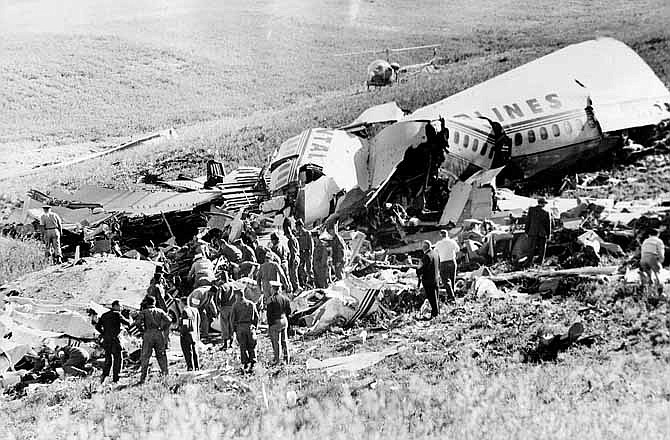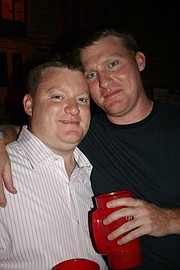UNIONVILLE, Mo. (AP) - Maureen Riordan's family barely spoke about the plane crash that killed her father when she was just 11. Same for Ronnie Cook, a Missouri soybean farmer who as a high school junior was among the first on the scene when Continental Airlines Flight 11 went down 50 years ago just south of the Iowa border.
Aviation buffs know Flight 11 as the country's first bombing of a commercial jet airliner, an act of sabotage by a passenger that killed all 45 people on board. Yet the crash of the plane, which departed Chicago en route to Los Angeles with a Kansas City stop, was largely forgotten as time passed, families moved on and more horrific airline incidents came to dominate history.
Now, as the result of efforts by a local historian and an aviation blogger, families who carried memories of the crash and residents who remembered that awful night are talking about it again. They include the children of auto executives and engineers who were on board and who are now in touch with others affected by the disaster. A few weeks ago, more than 100 people gathered for a 50th anniversary observance in Unionville, where an updated memorial that describes the crash was unveiled on the downtown courthouse square. The monument was first put up two years ago, although only with the names of Flight 11's eight crew members and 37 passengers.
Until recently, "folks here put it aside, more or less," Cook said. "It was something that happened. Life went on. We just didn't talk about it." But the new attention, he said, "was something that should have been done a long time ago."
Initial reports blamed a severe thunderstorm for the crash on May 22, 1962. But investigators soon determined that passenger Thomas Doty, a suburban Kansas City salesman facing armed robbery charges, was responsible for the explosion. He detonated six sticks of dynamite in the plane's rear bathroom as part of a botched plan for his wife, 5-year-old daughter and unborn son to collect on a life insurance policy he purchased moments before takeoff.
The FBI investigation was led by Kansas City special agent in charge W. Mark Felt, who would later earn acclaim as the Watergate whistleblower known as Deep Throat.
Some believed the bombing helped lead to tightened airport security measures a decade later and partly inspired author Arthur Hailey's 1968 book "Airport," which became a popular movie that spawned a run of 1970's disaster films. But airline bombings by then were already entrenched, said aviation historian Bill Waldock, a professor of safety science at Embry-Riddle Aeronautical University.
Previous incidents had targeted propeller planes. An October 1933 bombing of a Boeing 247 plane flying cross-country from Newark, N.J. to northern California killed all seven people on board. And in November 1955, Jack Gilbert Graham of Denver planted a bomb in his mother's luggage on a United Airlines flight to the West Coast, killing all 39 passengers and five crew members. He too was motivated by a desire to cash in recently purchased life insurance policies.
Local historian Duane Crawford began resurrecting interest in Flight 11 about a decade ago. His efforts caught the attention of aviation blogger Andrew Russell, a 26-year-old New Zealander whose website began to attract the children of Flight 11's passengers and crew.
Those who came to this observance included Riordan, who said her family never considered going to the scene of the accident earlier because "it wasn't something you did in those days." But Riordan, who lives near Hilton Head in South Carolina, said she always had an underlying urge to know more about the death of her father, a high school athletic star who became a chemist after World War II. He died on a business trip, as did many of the victims.
"They all had the same story, nobody talked about it," Riordan said after talking to other surviving children. "Dads who were going off to do their jobs, that's who traveled then."
Bob Gray, a 66-year-old Denver area resident, came to honor his uncle Fred Gray, the plane's pilot.
Capt. Fred Gray's death hit his nephew especially hard. The 50-year-old pilot had taken Bob Gray on his first motorcycle ride, his first flight as a student pilot and for his first flattop haircut. Bob Gray, who later earned his pilot's license and worked as an aviation engineer, named his own son after his uncle.
On the trip, father and son met strangers who also lost loved ones a half-century ago.
"A lot of people felt a kinship that they just didn't even fathom could exist, 50 years later," said Gray, who at the memorial service reconnected with a first cousin he hadn't seen in decades.
The memorial service's keynote speaker was Russell, who said he created a Flight 11 remembrance on his website to fill an information void about the incident.
"Here's something that's been forgotten," he said. "You can't Google it. There's nothing."
For Crawford, a Vietnam veteran and retired high school history teacher and football coach, the quest to tell the story of Flight 11 became a passion. His efforts helped the local historical society obtain several crash site artifacts, including fragments of pinion shifts, hydraulic junction blocks and other pieces of debris that were scattered over 40 miles in Iowa and Missouri.
He wanted to pay tribute to the victims, Crawford said. "Every family has got a story," he said.
Fred Gray and his co-pilot were found strapped into their seats, their hands on the flight controls and emergency checklists nearby, with the plane's landing gear down and locked.
"I know that my uncle had fought as hard as he could," Bob Gray said.
The revived attention to the bombing has already had an impact. In 2009, at the request of family members, Continental agreed to retire the flight number.
Online:
Continental Airlines Flight 11 blog, http://continenalairlinesflight11.blogspot.com


